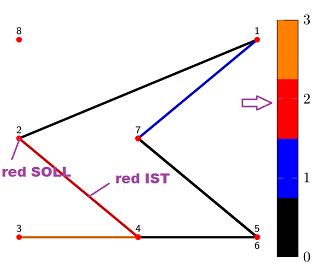|
Warum werden für eine Öffne in Overleaf
colormap={mycolormap}{ color(0)=(black); color(1)=(blue); color(2)=(red); color(3)=(orange); %color(10)=(black) % }, trotz der Einstellung Öffne in Overleaf
colormap access= piecewise constant die Farben nicht scharf getroffen? Bei Öffne in Overleaf
\documentclass[margin=5mm, tikz]{standalone} \usepackage{pgfplots} \usepgfplotslibrary{patchplots} \pgfplotsset{compat=1.13} \begin{document} \pgfplotsset{ colormap access= % map %direct piecewise constant %piecewise linear } % /pgfplots/colormap access=mapjdirectjpiecewise constantjpiecewise linear \begin{tikzpicture} \begin{axis}[hide axis, colorbar, % Versuch 1: %colormap={test}% % { % [0.1cm] % colormap steps: 1cm % color(0cm)=(black); color(0.1cm)=(black); % color(0.1cm)=(blue); color(1.1cm)=(blue); % color(1.1cm)=(red); color(2.1cm)=(red); % color(2.1cm)=(orange); color(3.1cm)=(orange); % % color(4)=(orange); color(12)=(black); % } % Versuch 2: colormap={mycolormap}{ color(0)=(black); color(1)=(blue); color(2)=(red); color(3)=(orange); %color(10)=(black) % }, point meta min=0, point meta max=3, %point meta = explicit symbolic, mesh/color input=colormap ] \addplot+[ ultra thick, % Punkte mark size=1.125pt, mark options={red}, table/row sep=\\, % Muss wohl so sein!? % patch, % Plot-Typ patch type=polygon, vertex count=2, % damit nur Kanten, keine Flächen, gezeichnet werden % % Angabe der Verbindungskanten ===================== patch table with point meta={% Startpkt Endpkt colordata \\% 1 2 0\\% Default; SOLL: black 1 7 1\\% SOLL: blue 2 4 2\\% SOLL: red 3 4 3\\% SOLL: orange 4 6 0\\% SOLL: black 5 4 \\% 5 7 \\% 6 4 \\% 6 7 \\% 7 7 \\% 8 8 \\% } % Angabe der Koordinaten ===================== ] table[header=true, x index=1, y index=2, row sep=\\] { Nr x y \\ 0 0 0 \\%0 1 2 2 \\%1 2 0 1 \\%2 3 0 0 \\%3 4 1 0 \\%4 5 2 0 \\%5 6 2 0 \\%6 7 1 1 \\%7 8 0 2 \\%8 }; % Beschriftungen ============================ % Laut Handbuch "replicate the vertex list to show \coordindex" % Anzeigen des 0. Aliaspunktes verhindern: \newcommand\Punktnummer{\pgfmathparse{\punktnummer>0 ? \punktnummer : ""}\pgfmathresult} \addplot[only marks, visualization depends on={value \thisrowno{0} \as \punktnummer}, visualization depends on={value \thisrowno{3} \as \Anker}, nodes near coords={\Punktnummer}, % every node near coord/.append style={ font=\sffamily\scriptsize, text=black, anchor=\Anker }, ] table[header=true, x index=1, y index=2, row sep=\\] { Nr x y Textposition \\ 0 0 0 south \\%0: 0. Aliaspunkt & south als Default für Standardposition 1 2 2 \\%1 2 0 1 \\%2 3 0 0 \\%3 4 1 0 \\%4 5 2 0 \\%5 6 2 0 north \\%6 Geänderte Textposition 7 1 1 south \\%7 Default wiederholen 8 0 2 \\%8 }; % Beschriftungen ============================ \end{axis} \end{tikzpicture} \end{document} |
Folgen dieser Frage
Per E-Mail:Wenn sie sich anmelden, kommen Sie für alle Updates hier in Frage
Per RSS:Markdown-Grundlagen
- *kursiv* oder _kursiv_
- **Fett** oder __Fett__
- Link:[Text](http://url.com/ "Titel")
- Bild?
- nummerierte Liste: 1. Foo 2. Bar
- zum Hinzufügen ein Zeilenumbruchs fügen Sie einfach zwei Leerzeichen an die Stelle an der die neue Linie sein soll.
- grundlegende HTML-Tags werden ebenfalls unterstützt
Frage-Themen:
gestellte Frage: 03 Sep '18, 15:25
Frage wurde gesehen: 5,242 Mal
zuletzt geändert: 13 Sep '18, 13:47


Ist die Frage zu abstrakt oder mein Minimalbeispiel zu umfangreich? Ich hatte schonmal etwas ähnliches gestartet, in letzter Zeit nochmal zweimal; scheints ist die colormap ein kompliziertes Gebiet...
Bei mir passieren andere interessante Sachen, je nachdem welchen Renderer ich verwende: mupdf, poppler.
Also mich beschleicht der Verdacht, dass es etwas mit einem Bug / einer Unvollständigkeit dieser
patch table with point metazu tun hat. Bei 'normalen' plots bekommt man es 'meistens' noch irgendwie mit Gewalt hin...Könnte das ein Bug sein oder ist die "meta-Datenverarbeitung" von
patch table with point metanoch nicht ganz ausgereift? Oder liegt es an falschem Bedienen meinerseits?Mmmhh, ich bin mir ja sicher, die Experten haben den Code mal getestet und wenn es eine einfache Lösung gäbe, wäre die längst bekannt. Da könnte vermutlich höchstens noch der Chef @cfeuersaenger helfen. :()